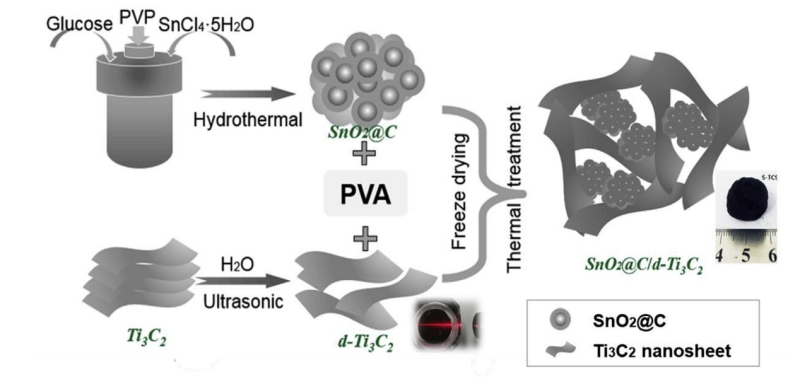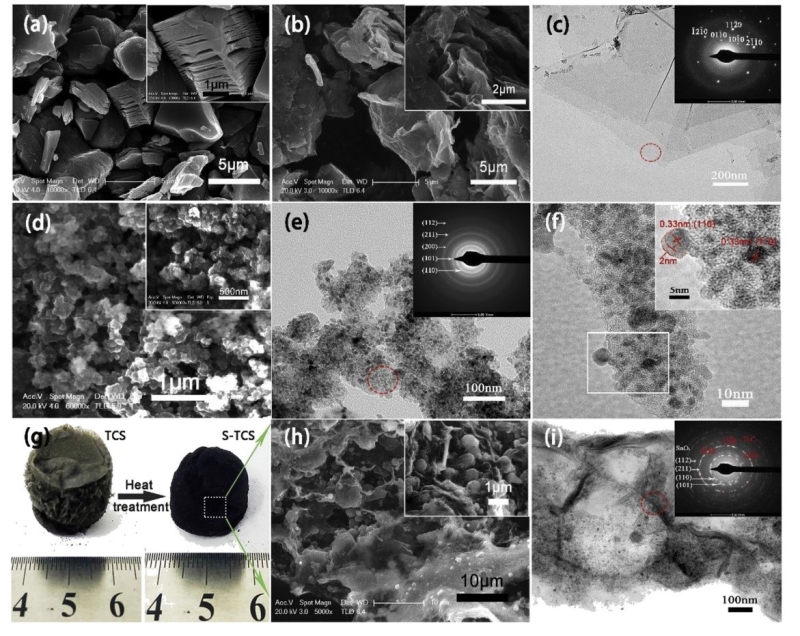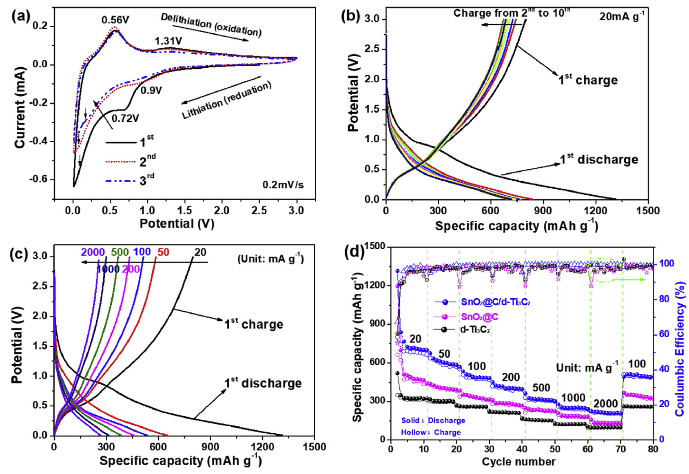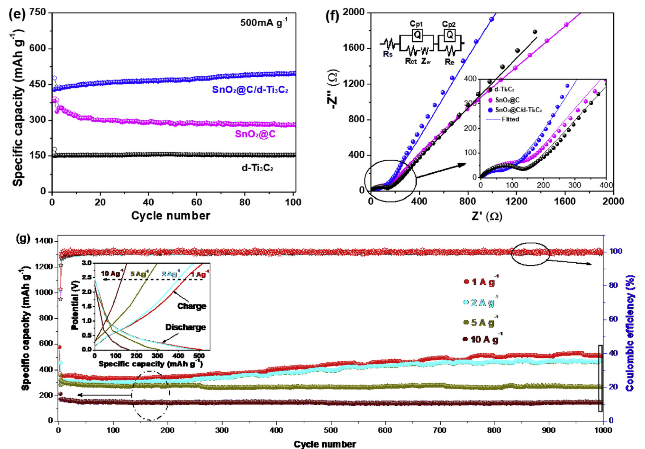用于高性能锂离子电池的三维干凝胶骨架结构SnO2@C/d- Ti3C2
3D d-Ti3C2 Xerogel Framework Decorated with Core-shell SnO2@C for High-performance Lithium-ion Batteries
二维材料MXene作为潜在的锂离子电池负极材料,然而由于其表面所带有的官能团限制了它的储锂性能。为提高储锂性能,在MXene表面上引入金属氧化物成为了一种较常见的手段。其中,SnO2以其具有高理论容量(782 mAhg-1)、无毒性、低成本、易制备、良好的化学稳定性等优点吸引了众多研究者的目光。但在储/释Li过程中所产生的较大的体积变化(>400%) 、明显的容量衰减等问题限制了SnO2的研究应用。为改善这一问题,考虑制备纳米SnO2以提高接触位置活性并且缩短扩散距离。
Two-dimensional MXenes as potential LIBS (lithium-ion batteries) possess lower Li storage capacity caompared to Graphene due to the surface functionalization. In order to fulfil the demand for high Li storage capacity. Some researchers have attempted to improve Li storage performance by introducing metal oxides (MOs) on the MXene surfaces.Among the many available MOs, SnO2 has attracted special attention because of its high theoretical capacity (782 mAhg-1), non-toxicity, low cost, facile preparation, and good chemical stability. However, it suffers from several drawbacks: (i) large volume variation (>400%) during the lithium insertion/extraction process, (ii) slow kinetics of ions diffusion and charge transfer due to poor electronic conductivity, and (iii) obvious capacity degradation in the long charge-discharge cycles. To alleviate these problems, nanocrystallized SnO2 has been developed to provide more active contact sites for Li storage and shorten the diffusion path for ions and electrons.
最近,东南大学的孙正明教授和陈坚教授课题组(为充分发挥金属氧化物(SnO2)与分层MXene(d-Ti3C2)的电化学优势性能,采用水热法合成碳包覆的SnO2纳米粒(SnO2@C),并通过溶胶凝胶法与d-Ti3C2自组装成三维干凝胶骨架结构SnO2@C/d-MXene;其作为锂离子电池负极时表现出优异的电化学性能和长循环寿命。。该论文发表在能源类期刊Electrochimica Acta上,博士研究生张恒为该论文第一作者。
Recently, Sun and Chen group in Southeast University reported a multiscale design for the synthesis of three-dimensional (3D) delaminated-Ti3C2 (d-Ti3C2) xerogel framework decorated with core-shell SnO2@C nanoparticles via PVA-assisted sol-gel process, in which SnO2@C nanoparticles are synthesized by one-step hydrothermal route and then encapsulated into d-Ti3C2 framework. Remarkable improvement in the electrochemical performances as the lithium-ion batteries (LIBs) anode is achieved. These findings have been published in the Electrochimica Acta.
全文链接:https://www.sciencedirect.com/science/article/pii/S001346861831716X

图1 三维干凝胶骨架结构SnO2@C/d- Ti3C2的制备流程图
Fig 1 Schematic illustration of the synthesis process of core-shell SnO2@C, d-Ti3C2, and 3D SnO2@C/d-Ti3C2 xerogel framework.

图2 各样品的扫描电镜和透射电镜图
Fig 2 (a-b) SEM images of Ti3C2 and d-Ti3C2 (high magnification images in the insets); (c) TEM image of d-Ti3C2 nanosheets; (d) SEM images of SnO2@C nanoparticles; (e) TEM image of SnO2@C; (f) HRTEM image of SnO2@C; (g) digital photos of SnO2@C/d-Ti3C2 before and after heat treatment; (h) SEM image of SnO2@C/d-Ti3C2 after heat treatment.


图3 电池循环充放电测试图
Fig 3 (a) Cyclic Voltammetry (CV) and (b) Charge-discharge (CD) curves at 20 mAg-1 for 10 cycles and (c) CD curves at different current densities of SnO2@C/d-Ti3C2; (d) the rate performance, (e) GCD cycling, (f) Nyquist plots of the d-Ti3C2, SnO2@C and SnO2@C/d-Ti3C2, and (g) the long cycle life of SnO2@C/d-Ti3C2 electrode and the inset is the CD curves at 1000th cycle under different current densities.
更多学术成果介绍: